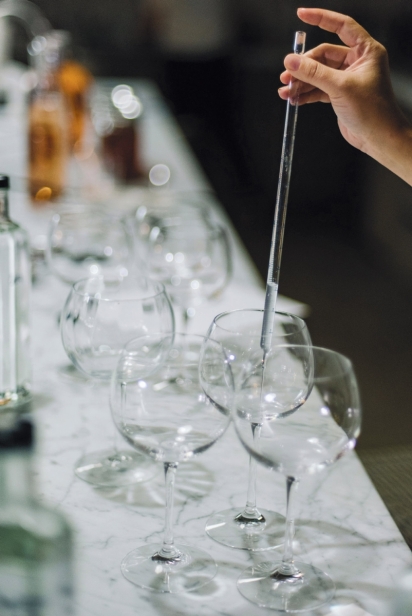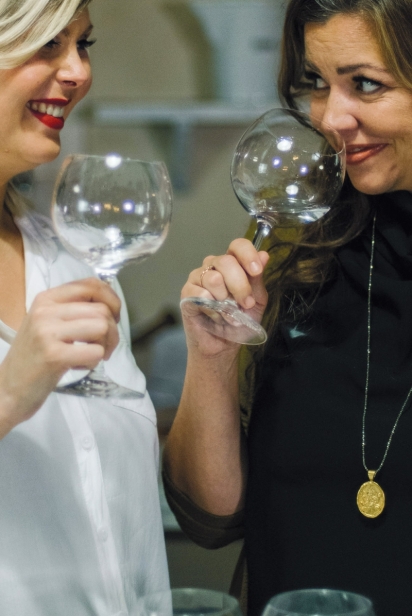When Life Gives you Smoke-Tainted Grapes
...Creative Folks Turn Napa cab into napa brandy
Napa may not be known for brandy. But perhaps it should be.
The summer of 2017 twisted Lindsay Hoopes into knots. Proprietress of Hoopes Vineyard in Oakville, Hoopes had taken over the family business from her father six years prior, after an illness made it too difficult for him to continue grape farming. In a quest to transition the business from farming to her passion of product development, she searched for a permanent residence in Napa where she could build her family’s brand.
After her eighth offer was outbid, fortune finally smiled on her. “My dad’s friend was sitting next to an old German guy at a bar who asked if he knew anyone looking for a property,” said Hoopes. The off-market opportunity came with a catch, though: The seller needed a 30-day close. Hoopes, pregnant at the time with her first child, sensed her chance and, in short succession, gave birth, closed on the property and found out her mother had cancer. “Then the fires hit,” Hoopes says.
THE CRUCIBLE
Hoopes’ 20 acres of vines, parceled in distinct lots that bookend Yountville, are mostly planted to Cabernet Sauvignon, Napa’s premier grape. Atlas, Tubbs, Nuns—with those fires raging nearby, Hoopes pushed her team to harvest everything. “What we understood at the time was that if you harvested quickly or were not close to a fire, there was not a certain hang time that equated to spoilage or no spoilage,” Hoopes said.
During harvest, Hoopes’ grapes were tested for smoke compounds and the results showed no smoke taint. “We thought we had gotten the grapes off [the vine] quickly enough and confirmed that with testing,” she recounts. Believing she had the data she needed to make the right business decision, Hoopes proceeded to vinify the grapes.
During various stages of sample tasting of the vinted juice, Hoopes and her team noticed elements of ash and smoke in the flavor profile but felt it wasn’t prominent enough; that these negative characteristics could be blended out.
It was not until December 2018 that she realized there was a problem. As the bottle date approached, the realization set in: Hoopes, like countless other vintners, was dealing with contamination. “I hearkened back to something my dad told me: “It is your name on the bottle. Don’t put anything in there you are not proud of,” he had counseled. She told her winemakers there was no way to bottle this juice and started calling insurance companies to see what could be done to stave off catastrophe.
As a grower-producer as well as purchasing grapes from others, Hoopes, along with other Napa wineries, found herself in a predicament that the current system was not designed to handle: Growers had been paid for a product that seemed fine when harvested, yet was undrinkable after initial processing. If a winery must rely on testing that cannot assess smoke taint until vinification or even later, at what point can a winery reject the grapes? And who is financially liable for that?
While the industry at large grappled with these liability issues, Hoopes had an immediate problem: a tainted product she had spent a year growing, another year and a half vinting, and no place to sell it. She feared she would bankrupt the family. “This 2017 was vinted, sitting in storage tanks waiting to be bottled, and I could not pull the trigger,” she said.
ENTER MASTER DISTILLER MARIANNE EAVES
Hoopes attended an industry event where she met Marianne Eaves, Kentucky’s first female bourbon Master Distiller since Prohibition. The two got to talking. Terroir, good grapes and sensitive handling are central to build flavor and body in wine. Distillation typically calls for neutral grapes and a different sort of finesse. Most important for Hoopes, it can extract undesirable characteristics. In the hands of a technician such as Eaves, the smoke-tinted clouds that hung over the beautiful flavor profiles of Hoopes’ Cabernet and other grapes could lift, revealing a distillate that was unique to Napa and to Hoopes’ vineyards.
“We weren’t looking to make a salvage product,” Hoopes said. “We wanted to follow these ideas about distillation that I knew to be true—that we could find these amazing flavors from our grapes. We wanted to create something delicious and revolutionary.”
Eaves and Hoopes went down the rabbit hole, playing around with spirit styles using a tabletop distiller in Hoopes’ kitchen and working in gallon-size test batches, eventually partnering with Spirit Works Distillery in Sebastopol and Young and Yonder Distillery in Healdsburg. The duo journeyed through gin, vodka and vermouth, pot and column stills, looking for a style and a product that expressed Napa in the finished product. Brandy rose to the top as their spirit of choice.
Eaves’ lack of brandy experience proved to be beneficial. “Very little of what we are doing is traditional for the industry,” she said. “Brandy makers are typically not working with robust red wines but neutral white grapes.”
WHAT IS BRANDY?
Brandy, from the Old English “brandywine,” is distilled from fruit juice. Cognac, for example, is brandy distilled from grape juice and Calvados is brandy distilled from apple juice, each brandy distinguished by the fruit grown in an AOC-designated region of France. Considering the status of place, Hoopes and Eaves knew that extraordinary Napa grapes could deliver high quality brandy.
With Eaves’ hands on the distilling levers, Hoopes found brandy to be a worthwhile hybrid, a spirit that retained the character and flavor profile of her Napa Cabernet grapes. The smoky flavors were removed from the first brandy batches, creating space for Hoopes to use her knowledge of winemaking to add back flavor with a barrel regime or secondary maturation. She brought in all manner of barrels—Marsala, new French oak, Cognac. “Ironically, we liked the Cognac barrels best,” Hoopes said.
To be called “brandy” in the United States, the distilled wine must rest in oak barrels for a minimum of two years (if bottled before that date, the label must read “immature brandy”). What they needed now was time for the distillate to rest.
2020—ANOTHER REALITY CHECK
The 2018 and 2019 harvests were, says Hoopes, beautiful and robust. They were vinted and are aging or have been released. But 2020 proved equally unfortunate for Napa growers. “In 2020, we had a lot of smoke over the course of two months—the entire valley was swathed in smoke,” Hoopes recalled. With 2017’s heartache barreled, Hoopes and Eaves’ proof of concept was showing well but the final results remained unknown. The continuing uncertainties with testing and insurance, however, empowered Hoopes to shift to brandy production before vinting the 2020 harvest, moving to shorten the “cycle of hurt.”
“It’s just too expensive to ‘see what happens,’” Hoopes said. She took in grapes from her neighbors rather than throw them away, upping her brandy production from 600 gallons in 2017 to 900 gallons in 2020.
Similarly to the 2017, the 2020 revealed no detectable smoke in the initial tasting. Eaves and Hoopes knew from the 2017 experience that smoke flavors would show up later. “It had an unusual mouthfeel, so we earmarked it for brandy production,” Eaves confirmed.
The equipment Eaves chose—a pot—column combo still—allowed Eaves to focus more closely on flavor. For the 2017, she utilized some of the trays in the column still to target certain aspects of the spirit. The 2020 grapes were distilled more like a whiskey. “We opened the column to give it a little more mouthfeel and a little more character,” she said. The 2020 will be aged entirely in Cognac barrels. “We are still waiting for the barrels,” Hoopes said, her industry as impacted by current supply chain issues as any other.
THE FUTURE IS CALLED MADAME X
Oasis by Hoopes, the permanent residence secured in 2017, is now an open-to-the-public regenerative farm (reservations required) and Hoopes is ready to create a scalable product around Napa brandy. She trademarked the term “Napanac,” anointing Napa brandy with a certification mark to define a unique product from a unique region. Hoopes envisions other Napa wine growers and makers using the title for their brandies. That might be a challenge, though. “I’m already getting pushback from Cognac,” Hoopes said. The duo are already discussing what comes next. Both found the 2017 and 2020 products so interesting, they are looking at crafting a product that intentionally adds smoke. And they are looking at malting houses. A “best option at the time” might lead to a new, Napa-driven spirit and a new concept of rarity.
Though the 2017 could release in May 2021 as brandy, Eaves is not quite ready. “We could go ahead and bottle what’s there but I think it will keep improving,” she said. “And I like the idea of keeping the 2017 as a marker of how the 2020 should be progressing.” Aging tends to be a beneficial value-add in brandies. When pressed, she conceded that it could be by the end of 2021 or another year out. What’s that old adage—good things come to those who wait? Keep an eye on Hoopes for the release of Madame X. Until then, keep waiting.
WHERE TO TASTE BRANDY IN NAPA
CALIFORNIA BRANDY HOUSE
E. & J. Gallo Winery is the force behind a tasting room that opened in early 2021 in downtown Napa dedicated to brandy. Gallo’s Argonaut Brandy, launched in 2017, recognizes that California brandy has been intertwined with wine production since the Mission days. Sample one of their four California-style brandies or discover the Cognac-driven spirit and independent ethos behind Germain-Robin, a Mendocino-based, French-style brandy producer acquired by Gallo in 2017.
1300 First St., Napa, 707.732.1200
CaliforniaBrandyHouse.com
NAPA VALLEY DISTILLERY
Established in 2009, an independently owned distiller crafts artisanal spirits and cocktail ingredients, including a range of brandies. A neutral brandy from single vintage, single estate, Napa Valley Sauvignon Blanc as well as flavored brandies (pineapple, Meyer lemon) are available to taste at a tasting bar at Napa’s Oxbow Market, in cocktails at its Hollywood Room Cocktail Bar within the Distillery and for tours and tastes at its Distillery.
2485 Stockton St., Napa, 707.265.6272
NapaDistillery.com






